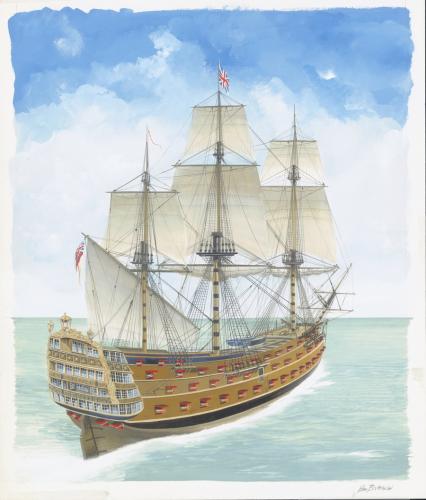Was The World’s ‘Northern-Most Island’ Erased From Charts?
by Kevin Hamilton (University of Hawaii) In 2021, an expedition off the icy northern Greenland coast spotted what appeared to be a previously uncharted island. It was small and gravelly,...




In an agreement for the financing, archaeological survey, excavation, conservation, and finally exhibition of HMS Victory (1744) and artifacts from the shipwreck site, the Maritime Heritage Foundation agreed yesterday to allow Odyssey to conduct the salvage operation.
HMS Victory was a British First Rate Warship that sank during a storm in 1744 while under the command of Admiral Sir John Balchin. Odyssey discovered her in 2008 and is the legal “salvor-in-possession” of the wreck. After a period of joint consultation between the UK Ministry of Defence and the UK Department for Culture, Media and Sport, and a public consultation period, the remains of HMS Victory were transferred to the Maritime Heritage Foundation in January 2012. The Foundation, a charity established to locate shipwrecks, investigate, recover and preserve artifacts to the highest archaeological standards and to promote knowledge and understanding of Britain’s maritime heritage, has now assumed responsibility for the future management of the wreck site.


“We are honored to work with the Maritime Heritage Foundation on the Victory project, an important piece of British naval heritage. Since our discovery of HMS Victory, we’ve continued to monitor the site and have sadly noted significant changes to the site including four ton cannon that have been dragged and damaged, as well as the illicit recovery of a cannon by another salvor, signs that the idea of preserving the site in situ is clearly not practical,” said Greg Stemm, Odyssey CEO. “We plan a phased approach which will include an initial non-disturbance survey and expect to begin the archaeological excavation as soon as practical.”
“We hope that this site will give us a unique insight into the world of the mid-eighteenth century Royal Navy,” stated Sir Robert Balchin, the Chairman of the Maritime Heritage Foundation. “We are very concerned that natural erosion, damage from fishing vessels and illegal looting may endanger the wreck and therefore we have planned an archaeological survey that will record the site before it deteriorates further. Odyssey Marine Exploration has proved its expertise and we are looking forward to working with them to protect the maritime heritage associated with Balchin’s Victory.”
Pursuant to the executed agreement Odyssey has produced an extensive project design for the archaeological excavation of the site, including a complete plan for recording, documentation, conservation, publication and public education. Once the project plan is approved by the Foundation, fieldwork is expected to begin in early 2012, depending on weather conditions and equipment availability.
The agreement calls for Odyssey’s project costs to be reimbursed and for Odyssey to be paid a percentage of the recovered artifacts’ fair value. The preferred option is for Odyssey to be compensated in cash. However, if the Foundation determines, based on the principles adopted for its own collection management and curation policy, that it is in its best interest to de-accession certain artifacts, the Foundation may choose to compensate Odyssey with artifacts in lieu of cash.
Odyssey will receive the equivalent of 80% of the fair value of artifacts which were primarily used in trade or commerce or were private property and bear no direct connection to the construction, navigation, defense or crew of the ship, such as coins or other cargo.
Odyssey will receive the equivalent of 50% of the fair value of all other objects typically associated with the construction, crewing and sailing of ships including, but not limited to, the ship’s hull, fittings, fasteners, construction elements, clothing, organic remains, foodstuffs, cooking utensils, pottery, weapons, ammunition, ground tackle and navigational equipment.
For any private property including coins or other cargo administered through the Receiver of Wreck, the Foundation has agreed that Odyssey shall receive 80% of the value.
A Private Curatorship Program will be established by the Foundation for certain artifacts from the site considered to be suitable for de-accession to prevent their irretrievable dispersal and to allow ongoing scientific study.
Join the gCaptain Club for curated content, insider opinions, and vibrant community discussions.


Join the 105,922 members that receive our newsletter.
Have a news tip? Let us know.
Access exclusive insights, engage in vibrant discussions, and gain perspectives from our CEO.
Sign Up




Maritime and offshore news trusted by our 105,922 members delivered daily straight to your inbox.



Essential news coupled with the finest maritime content sourced from across the globe.
Sign Up